It was lovely to be back at Badminton Horse Trials again this year, slightly dryer underfoot than last year with deck shoes being the footwear of choice rather than wellies! Having studied at the Royal Agricultural College in Cirencester and spent many a day following the Beaufort hounds around the beautiful Badminton estate, it always feels slightly nostalgic being back. The Horse Trials is a great opportunity to catch up with old ‘Ciren’ friends who come back each year to watch the eventing…or in some cases spend the weekend shopping and enjoying a Pimms or two without managing to see a horse at all!!
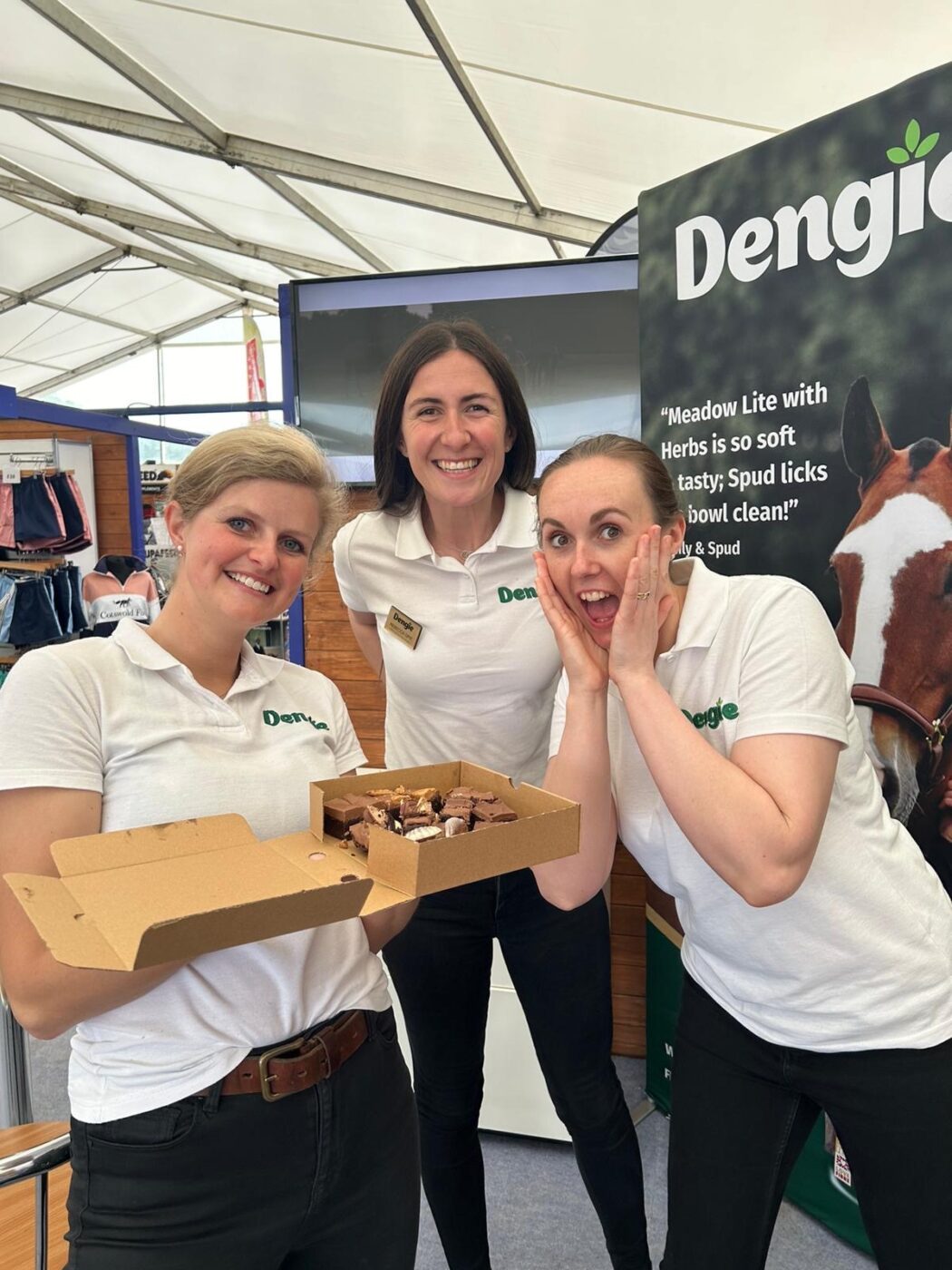
Badminton Horse Trials is one of the biggest 5* events in the eventing calendar and is a fantastic opportunity to watch top class riders from all over the world. We were particularly proud of Dengie supported rider Alex Bragg and Quindiva who, after a fantastic cross-country round and being one of only three to go clear in the show jumping, climbed from 51st place after dressage to finish on the podium in 3rd place. Quindiva is fed on Dengie Alfa-A Oil with a balancer, which obviously gives her plenty of slow-release energy to compete and just goes to show, horses can compete at the top on a fibre-based diet!

Working on the Dengie stand is always a great place to chat to customers, both old and new, offering nutrition advice for a wide range of different horses and ponies as well as some other species too. Dengie Meadow Lite with Herbs, which we launched at the end of last year, was very popular and it was fantastic to hear how well customers had been getting on with it.

During the quieter part of Sunday when the final ten were show jumping, we gained a new temporary team member ‘Ozwold’ who belongs to a friend of mine who went in to watch the jumping. He definitely brought the cute factor to the stand and thoroughly enjoyed all the attention and posing for photos!
There were some great bargains to be found in the shopping village with us all taking home goodies for ourselves and our horses. Food is always a strong talking point amongst the Dengie team and we enjoyed some brilliant brownies from the Pudding Waggon, who we visit each year at both Badminton and Burghley.
As a bit of a side note, I’d like to give a big shout out to the lady on the Sunday who was armed with baby wipes and helped when I managed to cover myself in duck sauce while trying to eat my lunch… Thank you!!
Thankfully, the traffic home was kind to us as we were all a little tired by Sunday evening and very much looking forward to being back to our own beds. Thank you to the team at Badminton for all their hard work that goes into organising such a fantastic week. I can’t wait to go back again next year!
At the end of April, Katie Williams, Claire Akers and I took a trip down to the south west, during which we enjoyed paying a visit to James and the team at GUL Outdoor Therapy in Wiltshire. GUL provides various outdoor activities, including equine assisted therapy, to individuals and groups to help improve mental and physical wellbeing.
They currently have 16 horses and ponies who are used for therapy, all of whom have been selected for their role based on their gentle temperaments. They are fed a Dengie fibre diet, which works well for them because it is high in fibre but low in starch. This means that the feed shouldn’t increase excitable behaviour, which is of course an essential consideration for therapy horses. Last year, GUL were involved in trialling our new Meadow Lite with Herbs before it was launched, and we are so pleased that they’ve had great success with it and have continued to use it ever since.
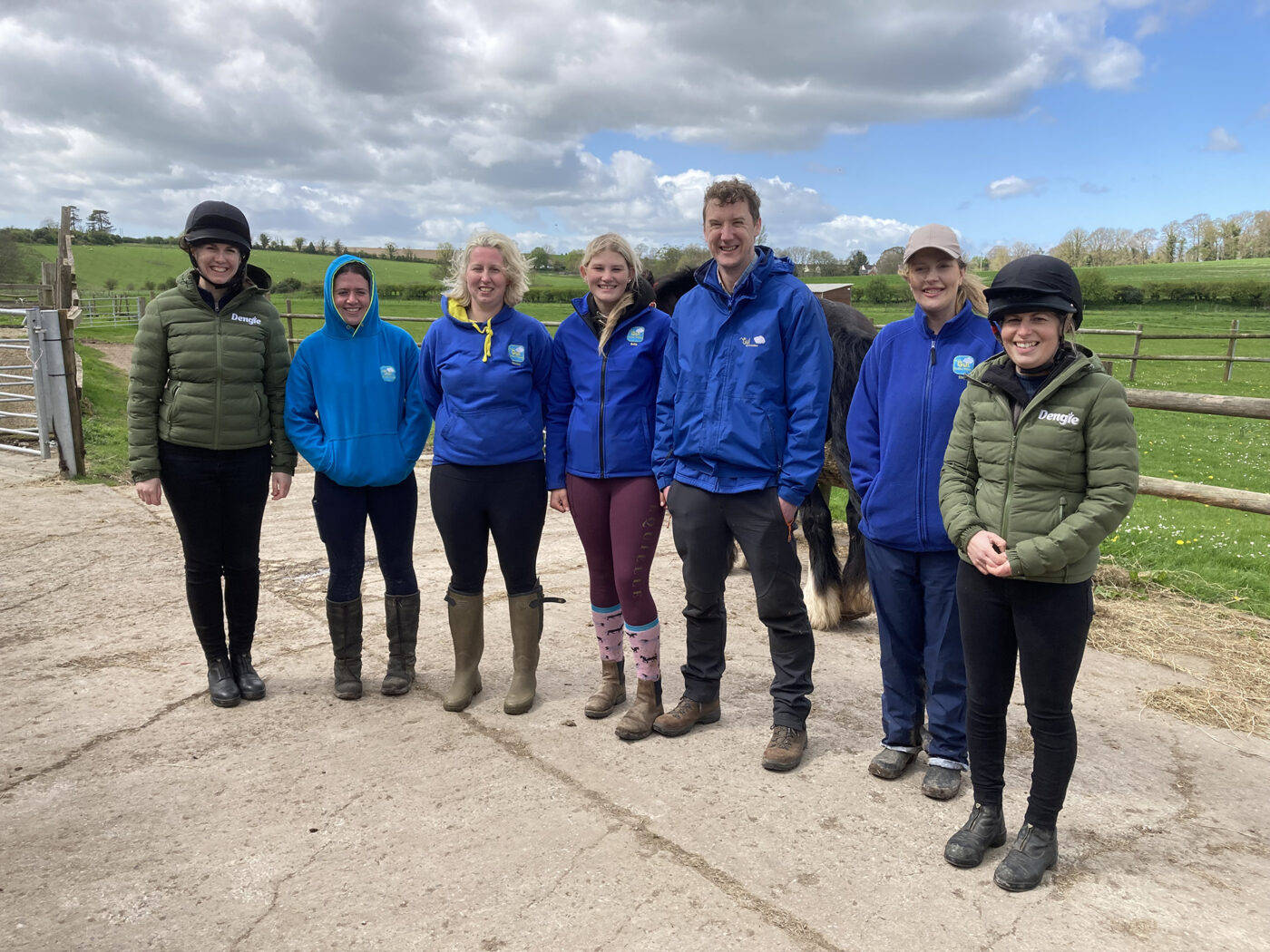
After catching up on how the horses are all getting on, we weighed them on our weighbridge, which the team at GUL found interesting to compare to previous records. We are also continuing our previous work on weigh tapes, and the horses and ponies at GUL were ideal candidates to take part. They have a variety of horses of different shapes and sizes, ranging from Anna, the 11.2hh Welsh pony, who weighed in at 296kg, through to William the Highland who was over 600kg.
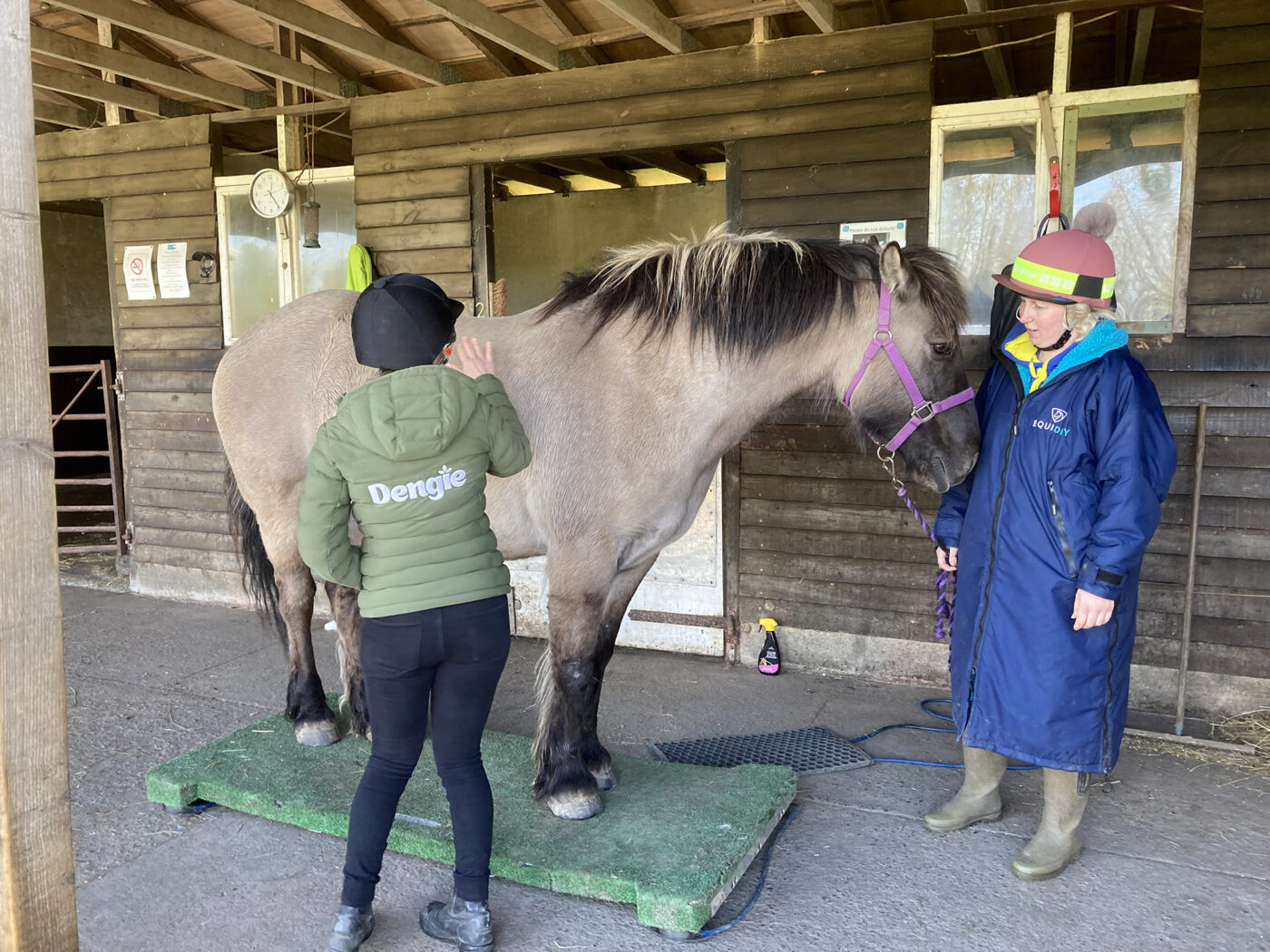
The horse with the biggest difference between the weigh tape and the weighbridge on the day was Betty, a lovely 16.2hh cob, who was 586kg on the weighbridge but just 461kg on one of the weigh tapes – a difference of 125kg! Brenin, a 14hh Welsh Section D gelding, had the smallest difference of just 2kg between one of the weigh tapes and the weighbridge. Whilst weigh tapes can be useful for monitoring changes, this shows why it’s so important to see how your weigh tape compares with a weighbridge if you have the opportunity – then you can work out what the difference is likely to be for your tape and your horse.
Despite the extremely blustery weather on the day, none of the horses batted an eyelid about walking on the weighbridge and being weigh taped, demonstrating why they are so perfect at their jobs!
For more information on GUL Outdoor Therapy and the work they do, please visit: https://www.guloutdoortherapy.org.uk/
This year we were delighted to be involved once again with Pony Magazine’s Big Day Out. The three sold-out events were held across March and April and were extremely popular. Meet and greets were held in the morning and the afternoon, with the opportunity to also browse the shops and trade stands, while the middle of day involved a fantastic range of demos and performances to suit all equestrian interests.
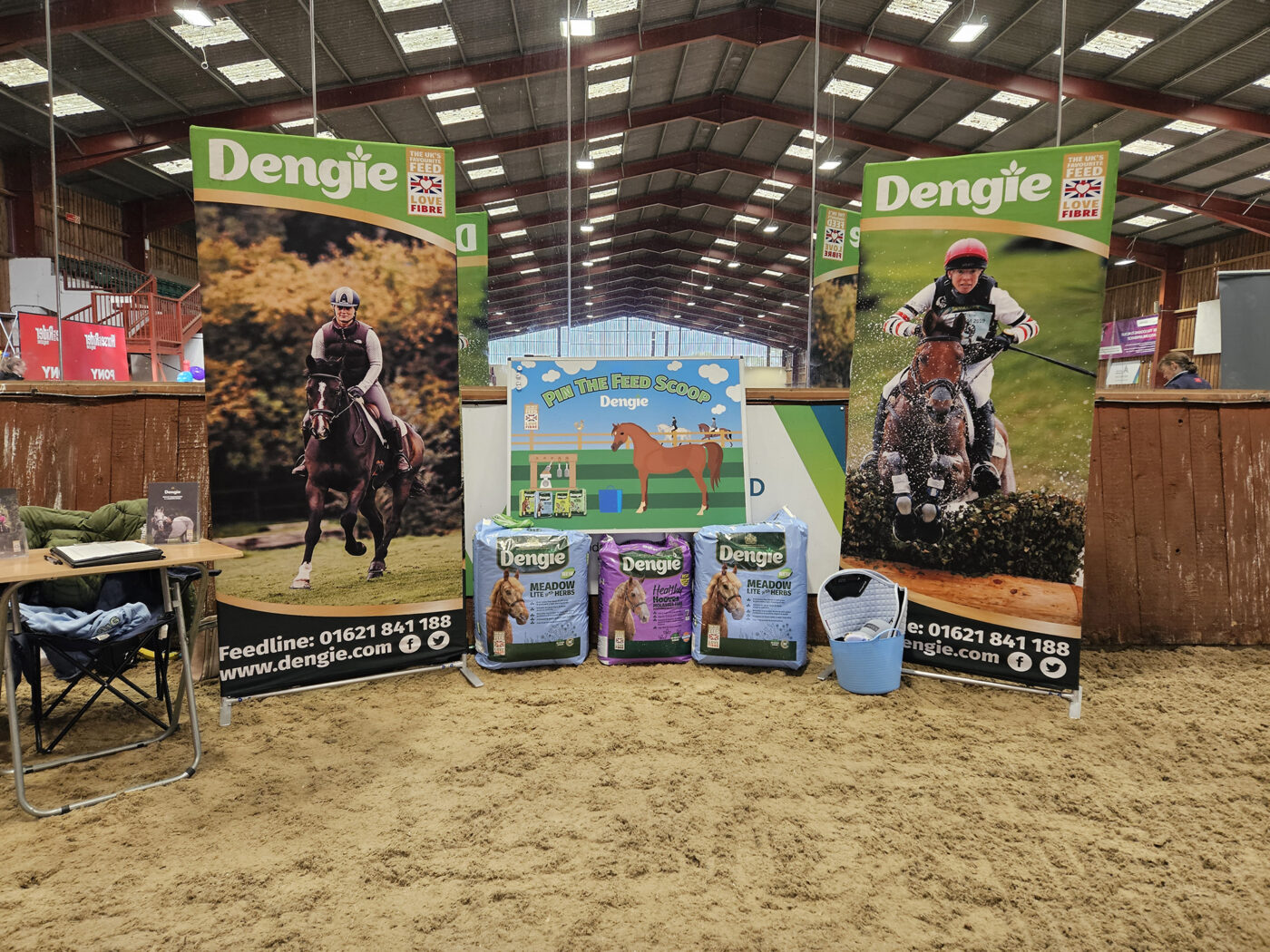
At the Arena UK and Bury Farm events, spectators had the opportunity to have a meet and greet with Dengie supported social media influencer, Georgia, aka Lil Pet Channel, and it was great for us to catch up with her and hear how Percy and Snip are doing on their Dengie diets. Bury Farm also saw a brilliant ridden demo, which went down well with the crowds, from Dengie supported rider, eventer Alicia Wilkinson and her fabulous horse, Pogo. Alicia has regular support and advice from Claire Akers, Dengie’s Performance Horse Nutritionist, to ensure her horses are in top condition to perform at their best. Pogo is fed on Healthy Tummy because he struggles to maintain his weight and he benefits from the added digestive support. Her other horses are currently fed on Alfa-A Molasses Free and Alfa-Beet, alongside a balancer, which she finds is a good combination to help maintain their condition and support performance without making them too fizzy. Fun fact – One of Alicia’s other horses, Rambo, features on our Healthy Tummy bag!
In the trade stand area, it was lovely to work alongside Claire Williams from the British Equestrian Trade Association (BETA) who was sharing valuable information with the young equestrians about the importance of a correctly fitted riding hat and body protector as well as offering free hat and body protector checks on the day.
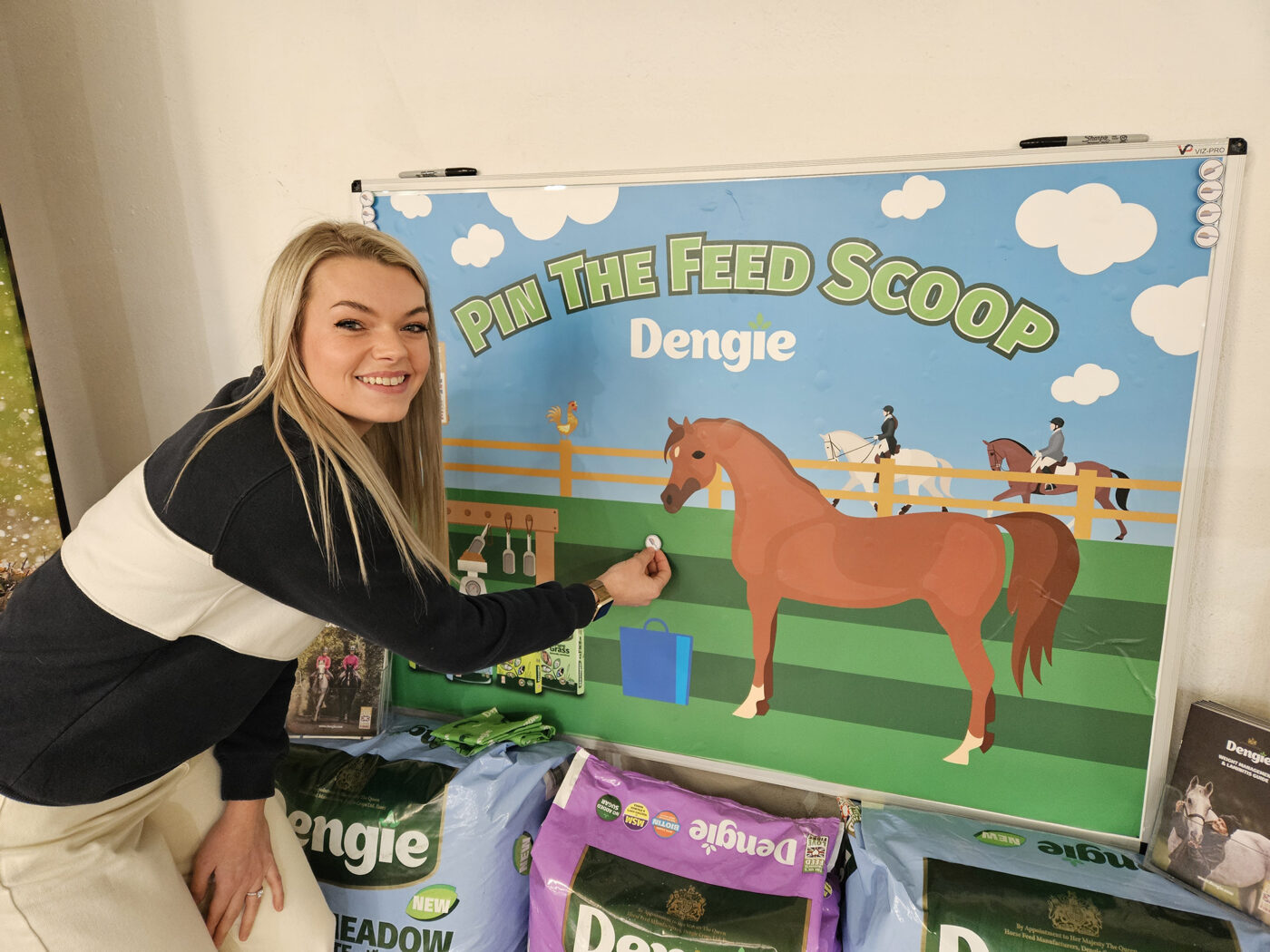
On the Dengie stand, we hosted a variation of the classic game, Pin the Tail on the Donkey, with the difference that participants had to get the feed scoop closest to the pony’s mouth for the chance to win a feed bucket full of prizes. We were certainly kept busy with lots of people (both children and their families!) wanting to take part throughout the day at every venue. We also loved helping out with people’s feeding enquiries for their own horses and ponies – if you missed us and would like help with your horse’s diet, do contact us on 01621 841188 or click here to fill out our Feed Advice Form.
Abel is my friend Clare’s homebred and on Friday it was his 2nd Birthday! I wanted to share his story as I have been visiting him regularly to weigh him and monitor his growth which I find fascinating. When I first weighed him at just a week old, he was 56kg and now age 2, he weighs 426kg.
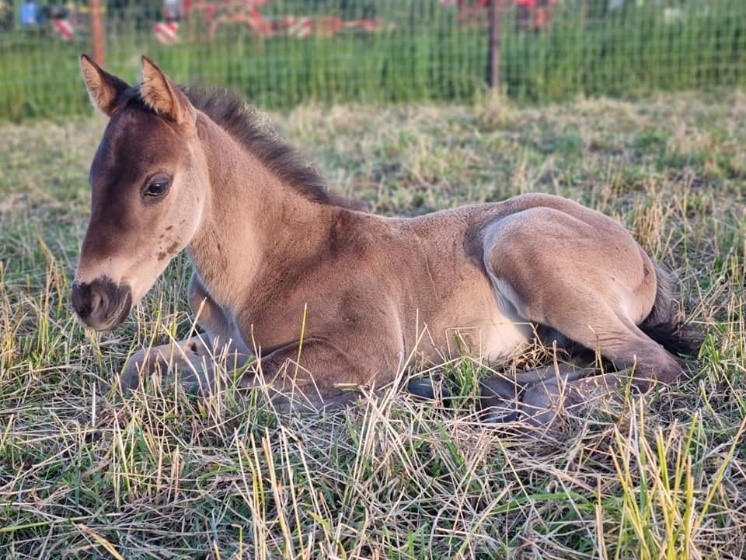
Abel’s mum Piglet was fed Dengie Meadow Grass with Herbs & Oil, Alfa-Beet and a balancer appropriate for supporting pregnancy. This was the same ration she had been on for a couple of years prior to being put in foal and so we decided to keep her on feeds we knew she liked and worked well for her. The quantity of balancer was increased in her last trimester, and again once Abel had been born, to provide her with additional nutrients to support a growing foal. The amount of Meadow Grass and Alfa-Beet was also adjusted alongside according to her body condition.
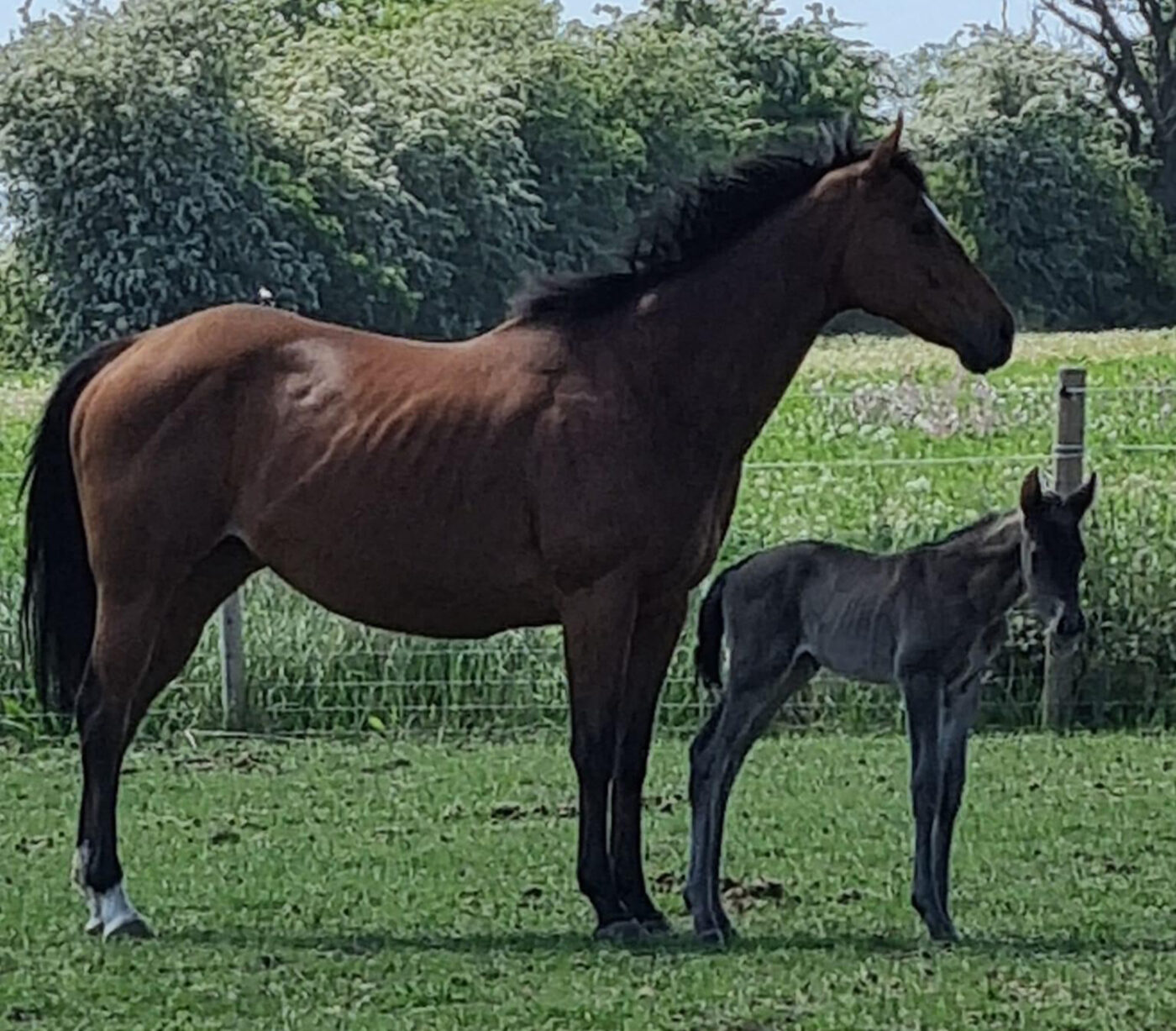
Monitoring and plotting your youngster’s weight every couple of weeks is a great way to measure whether you need to adjust the ration. If you see a very steep growth curve forming, you may want to reassess the diet, reduce energy intake, and consider making changes to the ration. In contrast, if the curve is very flat it’s an indication the foal isn’t growing very well which may indicate an underlying health problem or simply that the mare isn’t milking very well and so may require more feed. For further information on feeding youngstock click here.
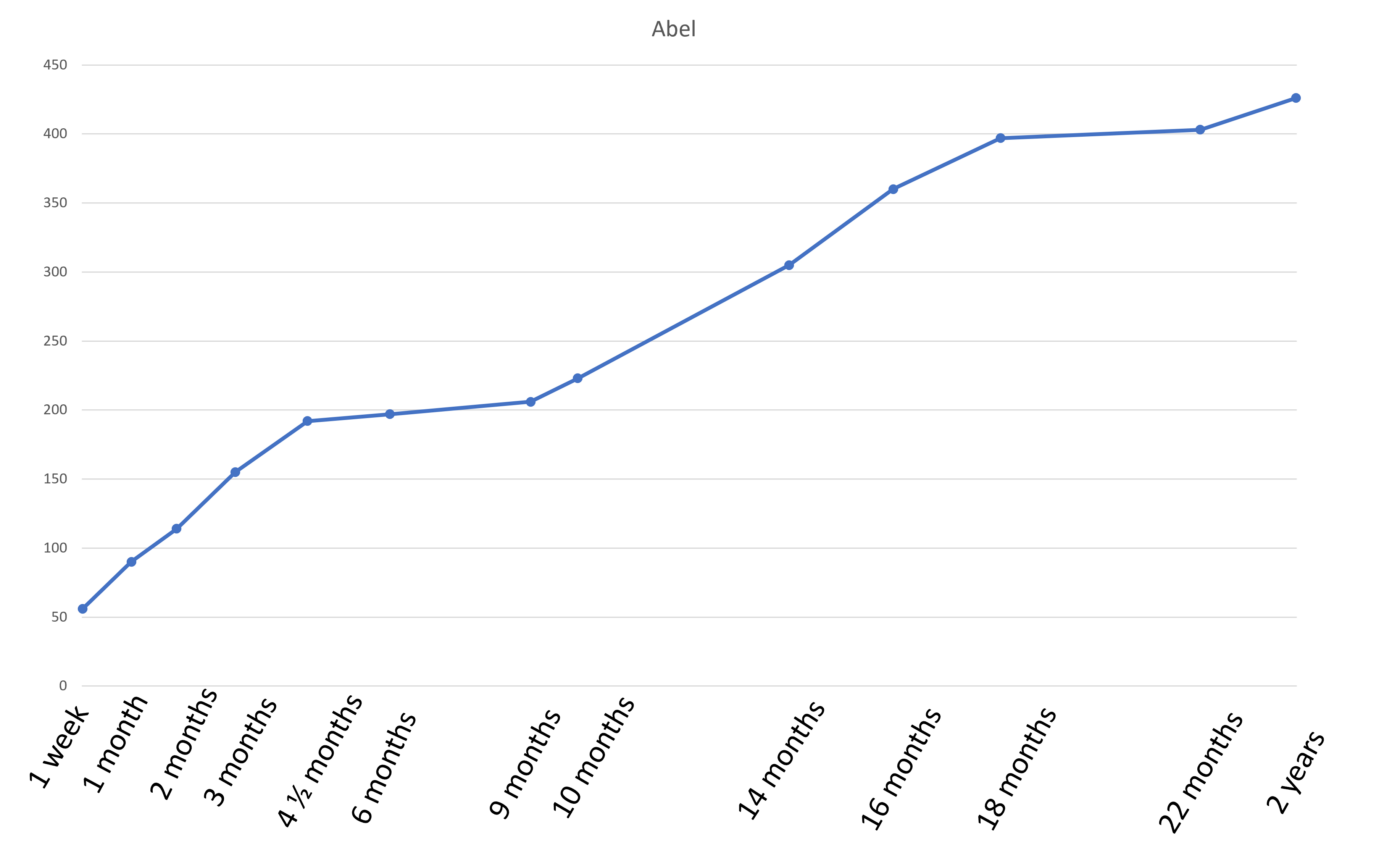
At around 1 month old, Abel developed ‘ballerina syndrome’ where his bones were developing quicker than his tendons, causing him to stand and walk on the tips of his toes. This was monitored closely but it resolved of its own accord and no veterinary intervention was needed. Throughout this time, the mare was kept on the same ration to ensure she was receiving a high specification of vitamins and minerals to support Abel’s growth and development.
Abel started sharing his mum’s feed from a young age and when weaned at around nine months, he went onto the same feeds; Dengie Meadow Grass with Herbs & Oil, Alfa-Beet and a balancer. This ration provided Abel with quality protein to support correct growth and development, good levels of calcium for bone development and hoof support as well as being fully balanced with regards to vitamins and minerals.
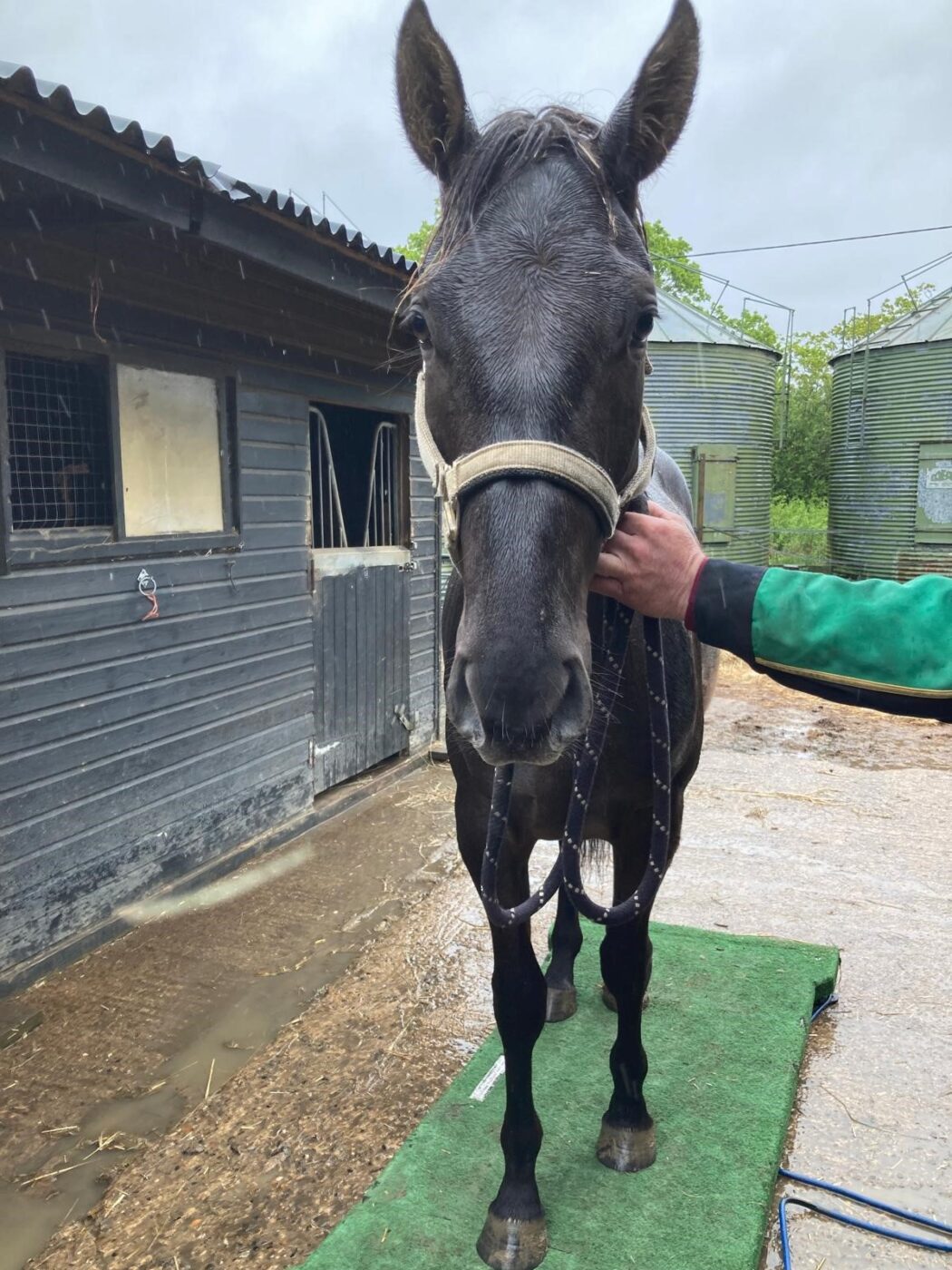
Abel was actually born and raised on one of Dengie’s farms in Essex surrounded by alfalfa! It has been lovely following his progress and watching him grow and I’m excited to follow his future. Clare plans to gradually back and bring on Abel herself when he is old enough, and hopes one day he will make an event horse.
For further advice and guidance on what to feeding your broodmare or youngstock please contact the Dengie Feedline on 01621 484182 or click here to fill in our Feed Advice form.
With the days getting longer and spring on its way, it’s the perfect time to give your chicken coop a spring clean!
On a warm, dry day remove everything from the chicken coop including all bedding and any perches. We would suggest wearing a mask and some gloves as it can get quite dusty and dirty! Starting with the ceiling and gradually working your way down the walls and to the floor, brush and remove any dirt, dust and grime with a stiff scrubbing brush, making sure you scrub into all the corners too. A paint scraper can be great for getting into the hard to reach areas, along the slats of wooden house and to remove dried on droppings from the walls, perches and nest boxes.

Kat from Hen Weekend Chicken Boarding, Hotels for Chickens adds, “If you have a plastic chicken coop use a small brush to get in around the screw heads and bolts at bit more or you can take it apart for a thorough clean. Mites have been known to hide in tiny little spaces such as screw heads and bolts, so use a small brush to target these areas. If you can take it apart for a thorough deep clean. One of my friends is a keen gardener and she takes all my old chicken bedding and manure for her vegetable patch, perhaps I’ll receive some home-grown goodies later in the season!” Click here to see how Kat spring cleans her chicken coops.
Next, use hot water and a detergent working from the ceiling down to the floor to get rid of the dirt that’s left before using a disinfectant all around. Make sure the products you use are suitable for chickens, there are plenty of options available to purchase through the British Hen Welfare Trust’s Shop.
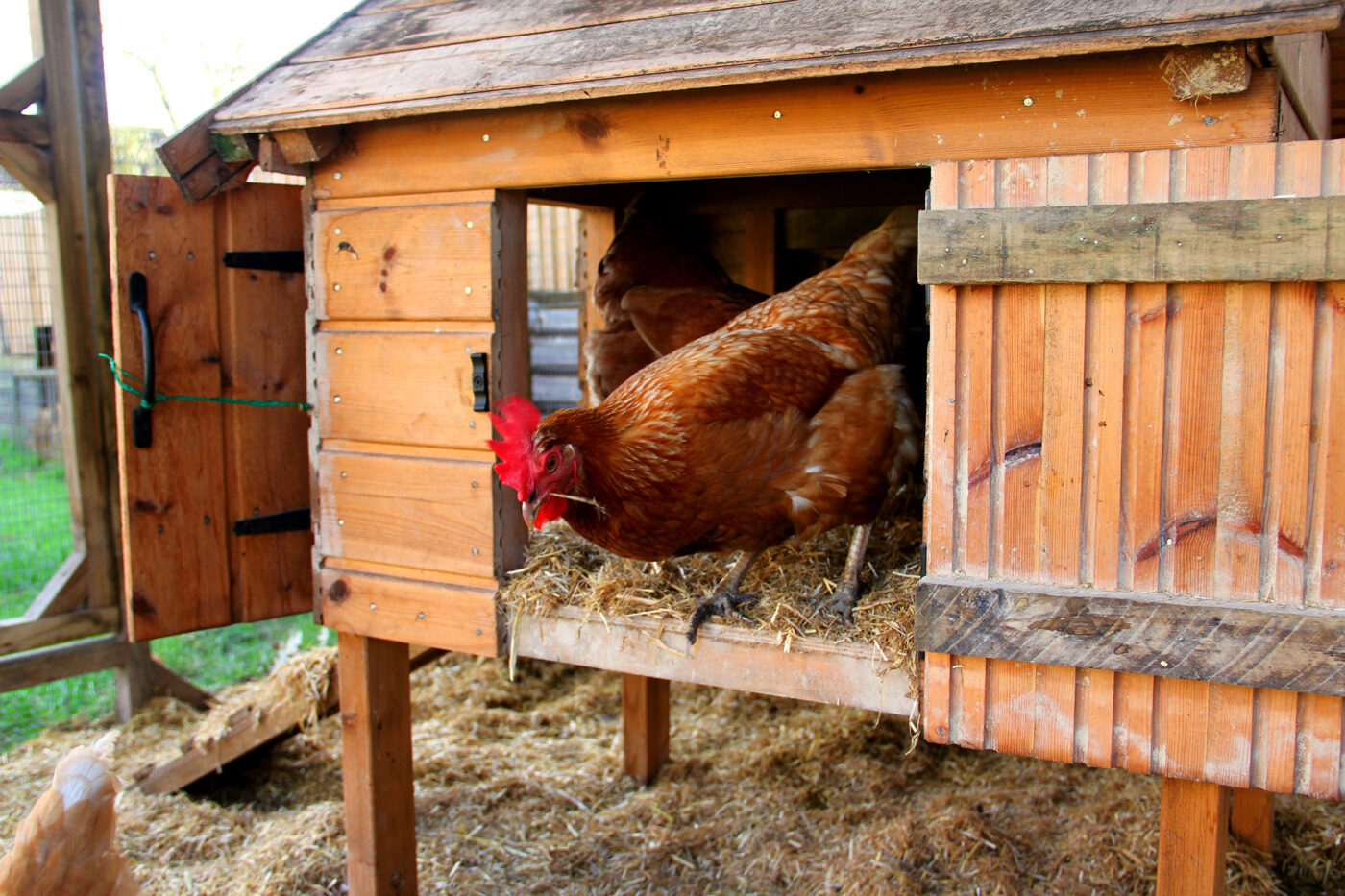
It is also important to give your drinkers and feeders, as well as any perches removed, a thorough wash and disinfect them too. Remember to rinse them well before allowing to dry and refilling.
As you are cleaning your chicken coop it is important to check for any damages that need to be repaired or replaced. You could also give your chicken coop a little paint or wood stain to give it a new lease of life!
Once everything is dry, perches, feeders and drinkers can be put back into the chicken coop along with fresh bedding. Dengie Fresh Bed for Chickens is made from chopped and dust extracted straw with a pine oil coating, providing anti-fungal and anti-bacterial properties. Fresh Bed for chickens was developed in association with the British Hen Welfare Trust to provide a clean bed for your chickens that is dust free and smells fresh. Most importantly chickens love it!
“I use Dengie Fresh Bed in my chicken coops. The pine oil helps deter mites and the fresh smell is amazing! Chickens like to be clean, and I love watching them snuggle down come bedtime” adds Kat.
For more information about Dengie Fresh Bed for Chickens call the Dengie Helpline: 01621 841188 or visit our contact page.
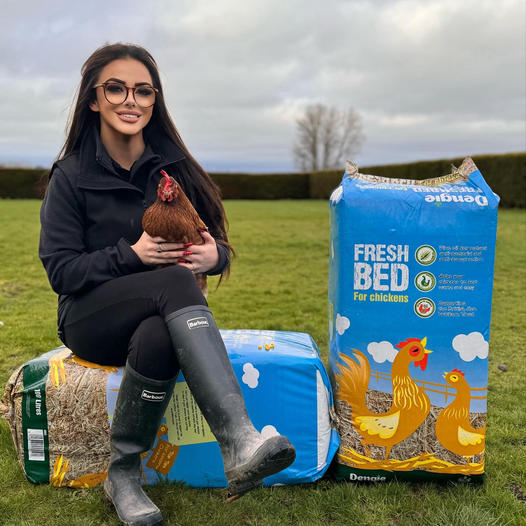
A little while ago I, along with the rest of the Dengie Nutrition team, attended a training session with Rosa Verwijs who is an IAABC certified Equine Behaviour Consultant and Lecturer at Anglia Ruskin University (ARU) Writtle. The aim of the session was to help us to help those who use Dengie’s portable weighbridge, especially if their horses are a little reluctant to get on the bridge!
When horses are asked to stand on the weighbridge they can be unsure as to what is being asked of them. Most of the time they will happily get on after a good look and sniff but sometimes they are not at all keen and if the owner isn’t very experienced, there is the potential for the situation to escalate – the last thing we want is for the horse or owner to have a bad experience. We therefore wanted to learn from Rosa how to help owners in this scenario whilst being mindful of everyone’s safety.
The team started the session by learning the basic principles of body language of the horse, at rest and during stress, taking into consideration the posture, movement and facial expressions of the horse. With two horses from Writtle, the team were then shown how to train with positive reinforcement by using a clicker or verbal marker and a reward, learning about timing and its importance during training.

The team also learned how it is possible to simulate a weighbridge by using poles and rubber matting that owners could use in their own time and take the time needed to help desensitise their horse. We noted how important it was to ensure the simulated weighbridge was flat and did not move in the wind or with the horses body weight. This was all great advice that we have included in a handout for anyone who books a clinic with us. We can send it in advance so they can prepare for our visit.
The desensitisation process starts with the horse and handler standing away from the “weighbridge”, whilst reinforcing every step the horse took closer to the ‘weighbridge’ with a verbal marker such as “good” and following up with a reward, continuing to gradually approach the “weighbridge”. Then the horse is cued to step on the “weighbridge” one step at a time whilst marking and rewarding the behaviour until the horse is happy to stand on the “weighbridge” with all four feet. This process can be repeated and the horse asked to stand on the “weighbridge” gradually for longer periods of time (1 second, 2 second etc). Throughout the training the horses were given frequent breaks as shorter training sessions are more productive.
Getting to grips with clicker training and reward timing, the team were taught how to help desensitise horses who cannot be trained with food, due to medical reasons, disinterest in food or for those that are too anxious or excitable. Instead of rewarding with food, the team were shown how to train with relaxation, waiting for the horse to fully relax whilst paying attention to the “weighbridge” before moving on to the next step.
There was no such issue in rewarding the Dengie team with food. After a full day of learning and training, our reward was a good cup of tea and some lovely cake and biscuits!
Over the last few weeks I have had the pleasure of attending the British Dressage Youth National Academy camps to assess the horse’s diets and to talk to the riders. The two camps are held at the very impressive Kilbees Farm by kind permission of Sarah Pidgley. The facilities and hospitality at Kilbees are second to none and it is a huge privilege to be invited along to work with the riders that have been selected for the camp.
Riders were selected from the Foundation Academy camps that were held during the autumn with just 12 athletes making it through to the National Academy. These lucky individuals were selected due to their dedication to the process, improvement shown, knowledge and ability. The National Academy camps aim to develop the skills of the riders and there are a range of mounted and unmounted sessions to help riders and horses to develop and fulfil their potential. I love the range of different activities which include rider strength and conditioning, saddle and bridle fit, nutrition for both the horse and rider, along with ridden coaching and test riding sessions. It feels like riders go away from these training camps with no stone unturned and with insight to what it takes to be a professional.
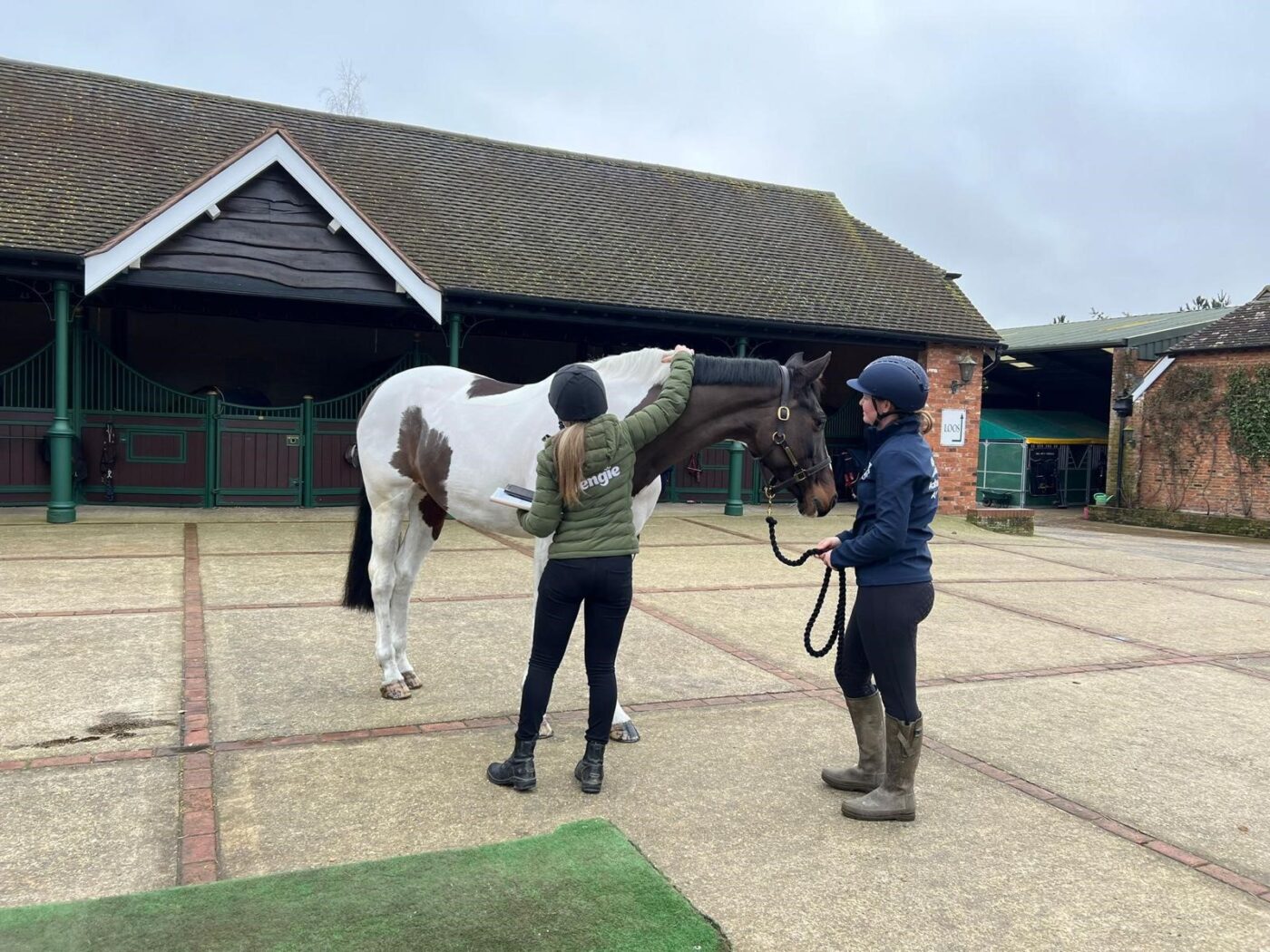
At the February camp I caught up with everyone to assess their horse’s condition and current feeding regime. We weighed and fat scored each horse to see how they had fared over the winter months and discussed the horse’s current feed, turnout and forage. I suggested tweaks to the rations if needed taking into account any changes to workload and condition.
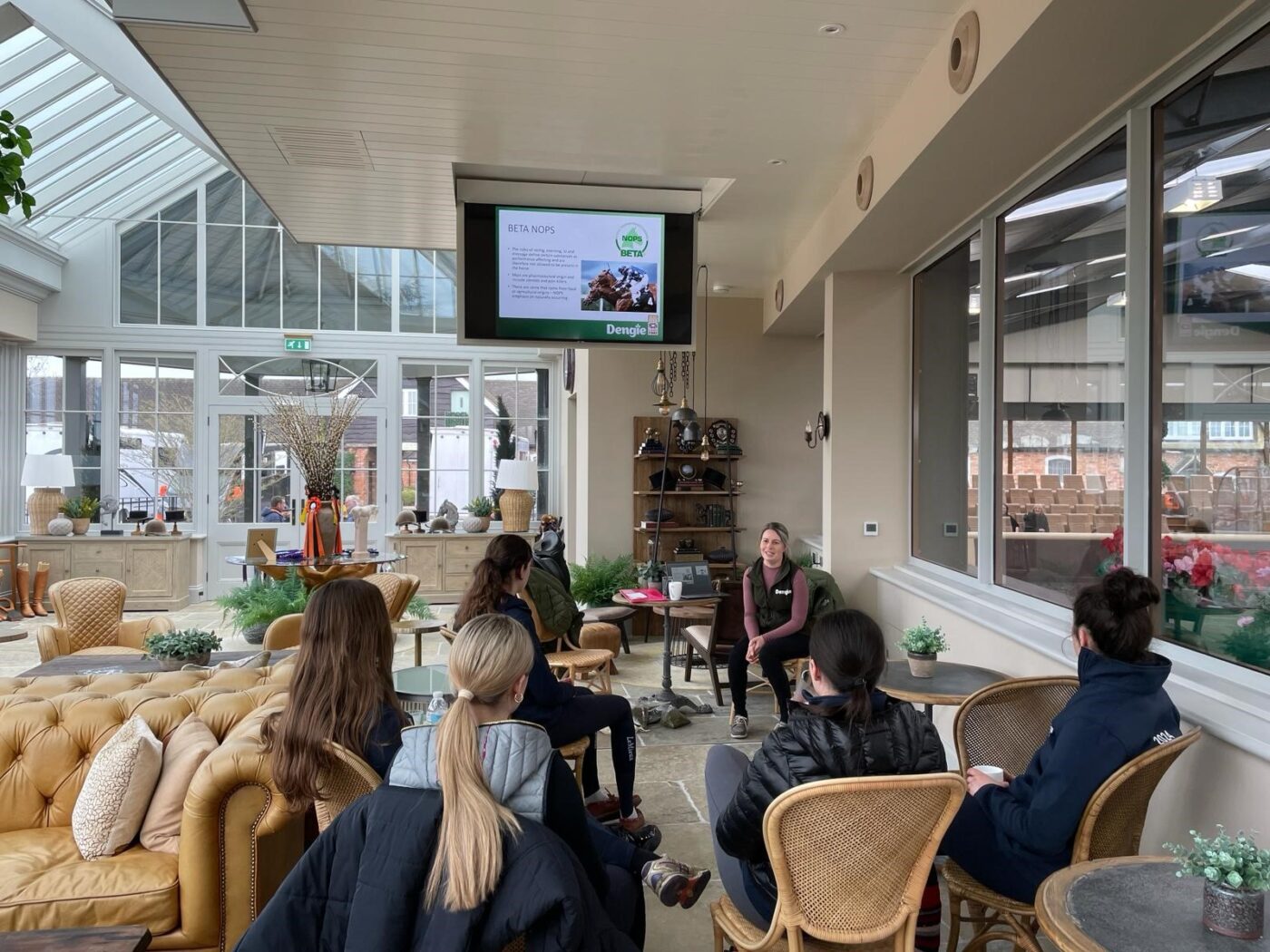
At the March camp we did a short talk taking a look at some of the different types of fibre ingredients used within the Dengie feed range to help riders understand more about the potential uses of different feeds.
We also discussed the BETA NOPS scheme which was set up by BETA in 2009. It is a voluntary scheme set up to address the risk of naturally occurring prohibited substances (NOPS) in feed and to allow feed manufacturers to show that they are minimising the risk of contamination of NOPS. Understanding the risks of NOPS is an important subject to discuss with riders competing under rules so they can understand and asses the risk of contamination within their yard situation and the products they are feeding. We discussed the benefits of using feed brands that have been accepted on to the scheme and ways to generally reduce the risk of contamination in the yard. Below are a few of our top tips which are useful for everyone:
- Know exactly where all the feeds, supplements, forage you use are coming from and what they contain – ignorance is no excuse. Be aware that even your vet may not fully understand the risks relating to NOPS
- Identify any potential sources of contamination – where do you make your tea and coffee on the yard, is it near the feedroom? Where do people have their lunch – does anyone sit on the hay bales to have a break?
- Implement good practice – don’t share buckets, scoops and stirrers, especially if medication is being used for some horses
- Keep batch details of feed – a photo of the statutory statement or label is ideal and retain a small sample from each batch if you can
All the riders went away with some positive and practical advice to help them plan and to reduce the risk of contaminations whilst they are out competing.
Previous Social Media posts regarding sugar levels in horse feed and forage have generated lots of interest. In one post we mentioned the sugar content in carrots which lead to many people being curious about the sugar levels provided by other fruit and veg, so this week I have been investigating the sugar levels in some popular fruit and veg we use as treats for our horses to provide information to update an article on our website.
Firstly, I went shopping to get a selection of fruit and veg that I find tasty and have routinely given my equines over the years including apples, pears, carrots, parsnip, swede and bananas. Not all equines like the same things and whilst my pony would have gobbled anything on offer, my horse used to be very suspicious of some items that perhaps she hadn’t had much experience of. Even though to me pears taste deliciously sweet, she would absolutely point-blank refuse them!

Secondly, I needed to establish the sugar levels in each item. Some of the items had nutritional information on the packaging and so it was easy to establish the sugar level from the back of the pack, but for the loose products I looked either at the supermarket’s website or another online ‘nutrition facts’ resource for the necessary information.
Thirdly, when we’re talking about sugar is it defined in the same way on labels for human food as sugar is defined on horse feed labelling? When human food is labelled, sugar must be shown as ‘carbohydrate- of which sugars’. Sugars in the label are defined as monosaccharides and disaccharides present in the food. You may see this as ‘total sugars’, or ‘sugars’ as well on some sites. It is important to look at what measurement the sugar is listed in as I found that it varied somewhat from ‘a typical pear contains’, to g per 100g, to %.
When sugar is listed on the label of a horse feed bag it is as sugar %. It is only a legal requirement to declare the sugar % on a bag of horse feed when a claim has been made about that nutrient – most likely that the product is low sugar. The Luff Schoorl method of analysis is used to report sugar level in horse feed and reports monosaccharides and disaccharides as well as some oligosaccharides up to 10 saccharide units. Further investigation found that the Luff Schoorl method is also used for human food as well and so when looking at sugar we can compare sugar in food and sugar in feed.
Fourthly, on my investigative journey was the decision on how to present the information gathered. This mostly stemmed from my ponderings on ‘well how big is the average pear?’. Other than because I needed to get some fruit and veg for the week, this is why I went shopping in the first instance so that I could weigh all my produce to determine how much sugar was in each item as well as showing the amount per 100g. This is important as we need to know what we or our horses are getting from the amount that we actually consume.
Lastly, I wanted to compare the sugar level in my items of fruit and veg to hay and some products that can also be used as treats in treat balls from the Dengie range. In the table below you can see that hay, because it is fed in larger amounts supplies a larger amount of sugar. In fact a 500kg horse being stabled overnight receiving 5 sections of hay will be getting around 1kg of sugar. By comparison the odd piece of fruit or veg or mug of Dengie pellets in a treat ball supplies small amounts of additional sugar.
| Item | Weight of Item (g) | Sugars g/100g as fed | Amount of Sugar in the Item (g) |
|---|---|---|---|
| Banana* | 202 | 12 | 24.24 |
| Braeburn Apple | 188 | 11 | 20.68 |
| Conference Pear | 152 | 10 | 15.2 |
| Swede | 443 | 5.6 | 24.81 |
| Parsnip | 155 | 5.7 | 8.84 |
| Carrot | 144 | 5.8 | 8.35 |
| Hay | 2kg (1 section) | 10 | 200 |
| Dengie Grass Pellets | 200g (1 cup) | 12 | 24 |
| Dengie Alfalfa Pellets | 200g (1 cup) | 5 | 10 |
*whilst horses will eat an entire banana including the skin, the sugar values are for the flesh only.
For more information on what to feed your horse or pony or for help and advice on all aspects of feeding call the Dengie Feedline: 01621 841188 or complete our Feed Advice Form.
Yuk is it still winter? Or is spring once again to be full of rain?
Either way, the winter preparation for the eventing season still needed to be done whatever the weather and the importance of feeding Dengie fibre was even more relevant for the horse’s nutrition and well-being, particularly with the grass not growing and fields turning into mud if we weren’t careful with turnout. Thankfully, my yard is on sandy soil so we can get away with turnout all year round, but the quality of grass is dependent on how wet or dry the weather is. Classically British to talk about the weather first isn’t it?
Our winter preparation begins in November. Whilst Quizical Z (Quiz), who finished the 2023 season at Osberton in the CCI3*-L, enjoyed a rest of relaxing in the field and hacking out, the younger horses were going out show jumping and to evening dressage at our local shows in readiness for their first BE90 event at Poplar Park in March. Once I was happy that Quiz had had enough time off we then focused on accomplishing our flying changes in readiness for the Advance dressage test that will follow in the new season.
During this time Dengie’s Performance Horse Nutritionist, Claire Akers MS.c visited to weigh and assess all the horses. We find this service from Dengie incredibly helpful especially in winter to see if any of the horses diets need to tweaking or if they need to increase their weight for the colder months to follow, particularly the older horses that we have on the livery yard.
Quickly, January was upon us and with some days being full to the hilt with the wind it did at least mean the ground was dry so I was able to practise the cross country at Poplar Park. We also went to Aston-Le-Walls for more cross country schooling having some fun with technical lines and bank complex’s.

The best highlight of the winter preparation was going to the Wesko Equestrian Foundation training at Solihull Equestrian Centre. I twent with two horses Billy Lira (Billie) and Quiz where we had jumping lessons with Philip Surl and dressage lessons with Nikki Herbert. The Dengie Nutrition team also attended and were brilliant in supporting all the riders by giving important feeding advice and weighing all of the horses.
After that, we went to the Barrier Health Pony Club Spring Festival where I competed Quiz in the Open Dressage Championships and Billie in the Intermediate Dressage Championships. It was perfect getting the horses out in an atmosphere and into a long arena before the start of the season.
Finally, it was the start of the new eventing season and we were back at Poplar Park for the first weekend of competition for British Eventing. Quiz was super in the Open Intermediate with a 29.8 dressage score and a double clear to come 3rd! Isington Red Faerie (Faerie) came 3rd in the Open 100 and The Bizzness (Izzy) and Billie was great in their Open BE90, overall it was a good weekend with the horses and fantastic results achieved. Thank you to all those that help and support me to do eventing full time!
I seriously recommend the feeding of Dengie’s fibre as it is the backbone to all my horse’s diet and getting them ready to perform at their best all year round whatever the weather!
In February, Dengie supported the Cambridge University Veterinary Society Keith Entwistle Memorial Lecture, which was this year given by Gemma Pearson on the topic of Equine Behavioural Medicine. Gemma is based at the University of Edinburgh and is also Director of Equine Behaviour for The Horse Trust. She is the only RCVS recognised specialist in Veterinary Behavioural Medicine (Equine), so she has a wealth of expertise on this topic. Claire Akers and I were grateful for the opportunity to attend, and it proved to be a fascinating evening. As nutritionists, we’re often asked by horse owners for help with feeding horses who can be stressy, spooky or nervous, but in many cases it’s not the feed causing the problem! So it’s really important that we keep up to date with the latest research in other areas of the industry to enable us to continue to give the best advice we can as well as knowing where to signpost owners to for further help and information.
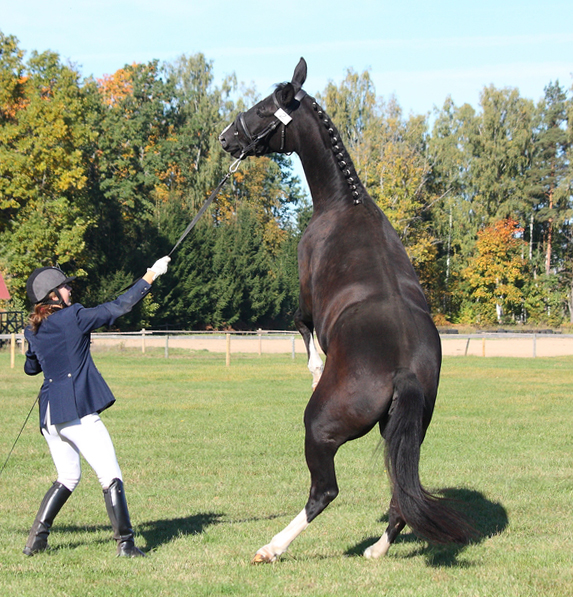
In the lecture, Gemma explained the principles of how horses learn, as well as covering different training methods, such as classical conditioning and the use of clicker training. She also showed several videos of the various training methods being successfully applied in different situations, ranging from a horse who wouldn’t pick her feet up to another who was headshaking in response to certain noises.
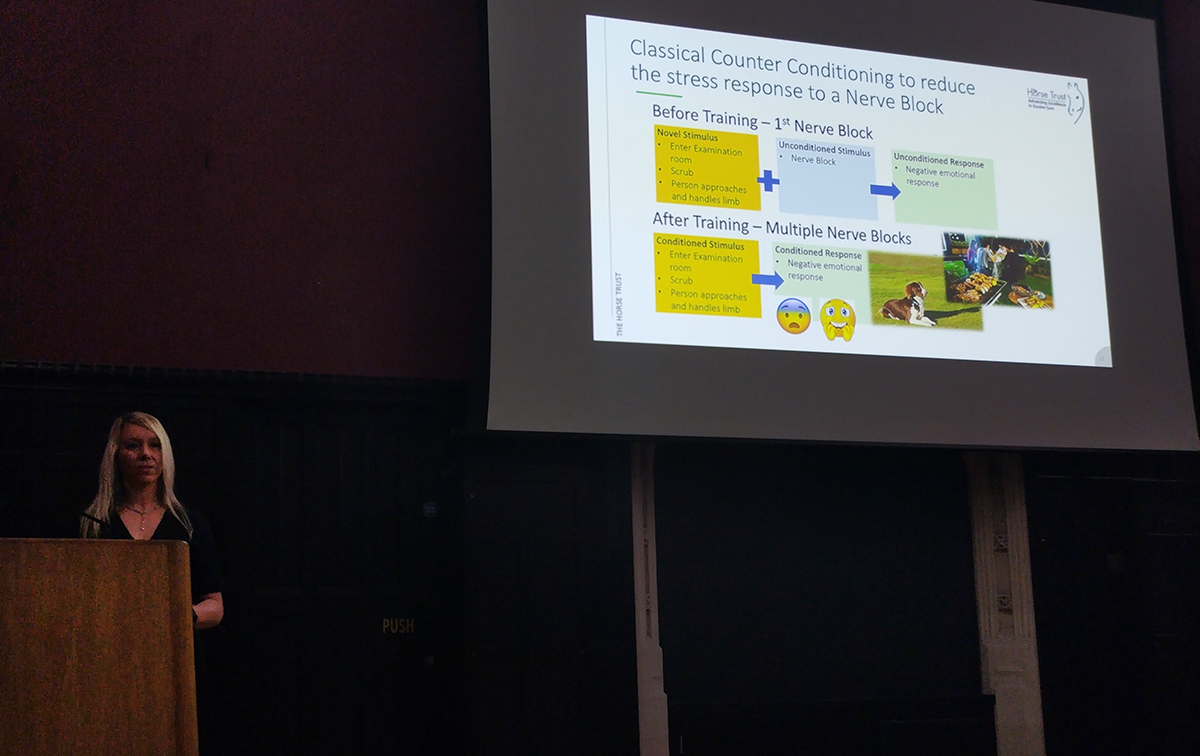
The topics discussed were extremely relevant for the veterinary students who attended. Research carried out in 2021 by Gemma and her colleagues at the University of Edinburgh found that 81% of equine vets surveyed had sustained at least one injury in the previous five years caused by a horse they were treating. Furthermore, ‘difficult’ horses were seen at least monthly by 95% of respondents, which gives an indication of just how frequently equine vets experience more challenging patients. Gemma highlighted how it is often forgotten that horses are flight animals, and ‘difficult behaviour’ is in most cases just a normal behavioural response to stress, so a good understanding of how they behave and learn is key to try and reduce the risk of injury.
From our point of view as nutritionists, although we don’t have to get anywhere near as ‘hands on’ as vets when we are out seeing clients’ horses, we do frequently encounter horses who are very nervous about new people or situations, so it was useful to get some additional tips that we can implement when supporting owners in encouraging their horses onto the weighbridge or when introducing a weigh tape to a particularly spooky horse.

Gemma finished the lecture by sharing some stories of the training methods being used in other animals. Did you know that London Zoo have successfully used clicker training in 75 different species? The most surprising of these was the tiny fish who have been clicker trained to swim into measuring jugs so that the keepers can easily move them between tanks without the use of nets!
If you would like support from a clinical animal behaviourist like Gemma, the register can be found here (veterinary referral is required).

